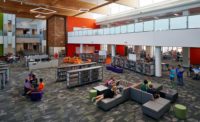Gloria Marshall also opted for an HVAC system that includes one geothermal system and individual heat pump units for every two classrooms. The 160 wells reach to depths of 300 ft. The heat exchange takes place at the classroom, improving energy efficiency, says Lam.
The school uses a demand control ventilation system to determine how much fresh air is needed based on the amount of carbon dioxide in the room, rather than bringing in a predetermined amount of outside air. For instance, when the classroom is empty, no new fresh air is needed. The system will cut the outdoor air requirements by about 40%.
“That meant less equipment to purchase and [less] energy used putting fresh air in the school while maintaining healthy levels of CO2 throughout,” Lam says.
The outside air units feature energy recovery wheels, which cool and dry incoming air before it goes into the geothermal system. Outgoing air passes through an exchanger connected to the water system to heat water.
In the kitchen, induction stoves eliminate excess heat entering the ambient air in the kitchen. Variable-speed exhaust hoods sense particulates and will adjust speed. All refrigeration equipment was placed outside.
SHW positioned Gloria Marshall to maximize daylight exposure in the classrooms and to locate the gym and kitchen so they insulate occupied spaces from southwest sunlight. It stacked classrooms two stories high and placed them around the building’s perimeter.
“South-facing classrooms are daylit, and we also used solar tubes on the second floor classrooms on the north bay,” Eich says. “It’s an open, light and airy school.”
A lighting control system will turn fixtures on only when necessary to provide 40 ft candles of light. Jody Henry, project manager for SHW for Gloria Marshall, anticipates the lights will be off 75% of the time.
Gloria Marshall collects rainwater in a 30,000-gallon underground cistern, which provides water to the dual flush toilets. A 5,000-gallon above-ground cistern collects water that runs through clear pipe in a science classroom to the courtyard, where it feeds the “eco-pond.” Students can study water damming and measure the amount of water coming in when it rains.
A rainwater collection and gray-water-harvesting system will supplement water from a 2,500-ft-deep freshwater well for irrigation at Lady Bird. Cisterns will collect roof water, air-conditioning condensate and water from showers and washers.
Gloria Marshall will use a project-based learning approach. Lam says the school is built “around projects students engage in.”
Many of the school’s environmental features will serve as teaching tools—such as calculating the area of the roof and how much water should enter the cistern, and how that would compare with the amount of water other containers might hold.
A small photovoltaic array at ground level will demonstrate solar energy and the effect on a light bulb of shading a portion of the panel. An electronic eco-screen in the lobby shows how much energy the solar and wind systems are generating, how much energy the building is using and how much water is being collected.
While students at Lady Bird will study in the net-zero environment, Irving ISD will bring students from other schools to learn about sustainability, renewable energy and water conservation.
“We need to do our part to educate future generations about the importance of the environment,” Layne says. “We hope [conservation] will become second nature to them.”
Four interactive learning nodes associated with each of the school’s green features will allow students to learn more about them. LED monitors provide data about power consumption and generation in real time and information about how the school was built. Interactive displays offer opportunities to learn about solar and wind power, geothermal systems and water conservation.
A load management system monitors power usage at each outlet. Students will be able to look at the screen to see how much power is consumed in their classroom and plug different items into the outlet to observe the power consumption.
Ann Richards features a sundial and an educational garden. Fred Montes, a partner with PBK, says such learning elements help the school become more sustainable. The Collaborative for High Performance Schools “looks at how you use the building, not just the building,” he says.
Article toolbar


